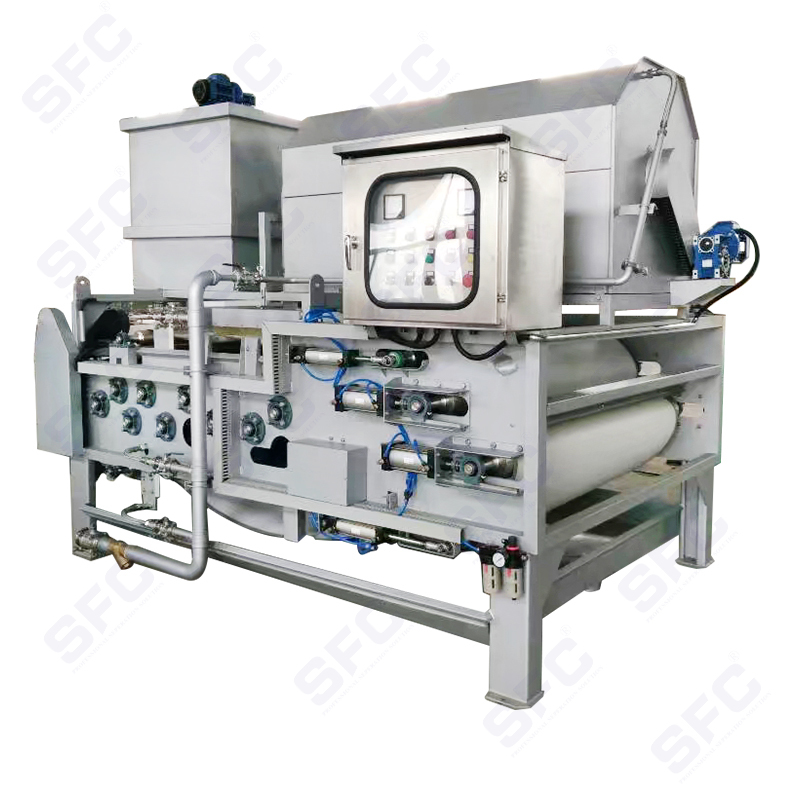How to improve wastewater treatment efficiency and achieve sustainable waste management through sludge dewatering?
In the realm of modern wastewater treatment, one of the most critical challenges is managing the by-product—sludge. Sludge, often resulting from the treatment of wastewater in industries or municipal systems, is a mixture of water, organic, and inorganic materials that can be difficult to dispose of safely. As global environmental concerns grow, efficient sludge management has become essential to minimize environmental impact and promote sustainability. This is where Sludge Dewatering Machines (SDM) play a pivotal role.
A Sludge Dewatering Machine is an advanced mechanical device used to separate water from sludge, significantly reducing its volume and making it easier to handle, treat, or dispose of. The dewatering process involves the removal of excess moisture, transforming the sludge into a more solid, manageable form. This process not only improves the storage and disposal efficiency but also enhances the overall treatment process of wastewater.
The machine typically works by using pressure, gravity, or centrifugal force to separate water from the solid sludge. The dewatered sludge, often referred to as cake, is then easier to transport and dispose of, or it can be further treated for use in various industries.

There are several types of machines designed for sludge dewatering, each with its unique mechanism and efficiency:
Belt Filter Press (BFP): A widely used machine in municipal and industrial wastewater treatment plants. It uses two belts to apply pressure and squeeze water out of the sludge. The belts are usually made of synthetic fabrics and pass through rollers, forcing water to drain out, while the sludge remains on the belt. The dewatered sludge then falls off the belt as a solid cake.
Centrifugal Dewatering Machine: This machine uses centrifugal force to separate water from sludge. The sludge is introduced into a rotating drum, and as the drum spins, water is expelled through the perforated drum walls. The solid material, or "cake," is collected at the bottom of the drum.
Screw Press: This machine uses a rotating screw to press and squeeze water out of the sludge. The screw pushes the sludge through a wedge-shaped zone, increasing pressure and causing the water to be expelled, leaving behind a solid dewatered sludge cake.
Decanter Centrifuge: Similar to the centrifugal dewatering machine, this device uses a high-speed rotating bowl to separate the water from the sludge. The decanter centrifuge offers higher capacity and more thorough separation, making it ideal for large-scale operations.
Volume Reduction: One of the primary benefits of sludge dewatering is the significant reduction in volume. Dewatering reduces the volume of sludge by up to 90%, which decreases the cost of transportation and storage. Smaller volumes mean less space required for disposal and a reduction in landfill use.
Environmental Benefits: Properly dewatered sludge is much less harmful to the environment. By reducing the moisture content, the chances of leachate contamination are minimized, and the risk of spreading harmful pathogens is significantly reduced.
Resource Recovery: In many cases, dewatered sludge can be further treated and processed into valuable resources, such as compost or biogas. Some industries use the dewatered sludge as a soil amendment, while others use it as a fuel source for energy production. This recycling process helps reduce the need for raw materials and can contribute to a circular economy.
Compliance with Regulations: Many regions have strict regulations regarding the disposal and treatment of sludge. Using a Sludge Dewatering Machine ensures compliance with local waste management laws, as it produces a cleaner and more manageable end product that meets regulatory standards.
Challenges and Considerations
While sludge dewatering machines provide numerous benefits, there are also challenges that need to be addressed. For instance, the performance of the machine can be affected by the type of sludge being processed, as different sludges have varying consistencies and moisture contents. Moreover, operational costs, maintenance, and the energy required to run these machines can be significant, making it essential for businesses and municipalities to choose the right dewatering technology based on their specific needs and budget.
Additionally, proper maintenance is crucial for ensuring optimal performance and extending the lifespan of the machine. Regular cleaning, inspection of components, and monitoring of sludge characteristics can prevent issues such as clogging or inefficiency.



 English
English Español
Español













